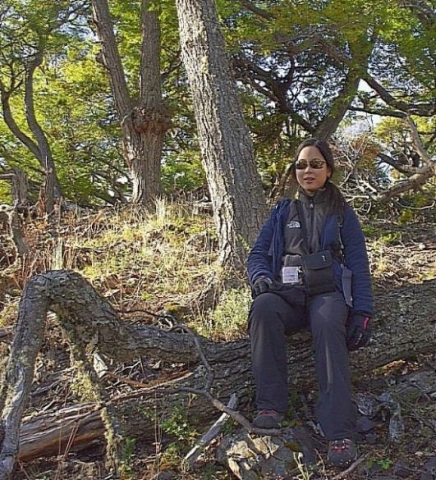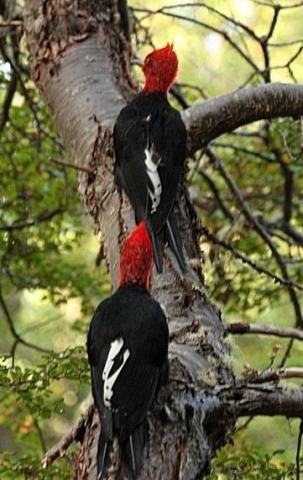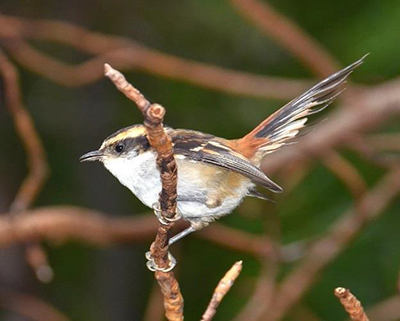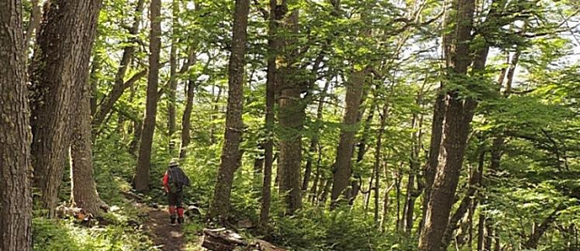Shu Yu Lin
Stanford University
The purpose of this project was to record bird songs in the Sub-Antarctic ecoregion of Chile, compose a piece of music that incorporates these recordings, and to perform the piece to the public. Field recordings were carried out on Navarino Island (Fig. 1), Chile with the assistance of researchers from the Sub-Antarctic Biocultural Conservation Program. These recordings were edited at Stanford University, CA, USA, and were used as the main source of musical elements in the piece Coexistence. It was a multichannel 3rd order ambisonic piece for 3D surround system. Furthermore, the piece was specifically composed for the Stanford Bing Studio where its premiere was held. Everything from recording the bird songs in the field, to the composition process, to performing the piece was extremely rewarding.

Two researchers from the University of North Texas, Texas, USA, Dr. Jaime Jiménez and Amy Wynia, a PhD student working with the Magellanic Woodpecker (Campephilus magellanicus) assisted me in the process of recording bird calls. There were two main methods that they applied. One was the double knock. This method was used to locate Magellanic Woodpeckers (Fig. 2) and it required a person holding two wooden sticks and hit a specially-designed
wooden resonance box twice concurrently. The resulting sound mimicked the signature double knock of the woodpecker and the sounds echoed in the forest. By doing this, distant woodpeckers heard the sound and knocked on a tree trunk

twice simultaneously in response. It was during this process that the researchers were able to find a family of Magellanic Woodpeckers and I was able to record the calls of juveniles and the knocking of the adult woodpeckers during their foraging bouts. Another method was to imitate the sounds of the other forest bird species (Fig. 3). By producing similar calls of these birds, they responded with their own. Eventually, these birds gathered around the sound source and responded by uttering calls. There, with a Zoom H4N portable recorder, I recorded these calls from a very short distance from the birds. The portable recorder and its accessories (i.e., a wind shield), were the recording instruments that I used during the recordings. These instruments produce quality sound and are suitable for outdoor recordings. Without the assistance of the researchers, I would not have been able to record the avian calls.

After I returned from Chile, I began working on the piece, Coexistence. This piece was designed to be an ambisonic multichannel piece for 3D surround system and it was especially composed for the Bing Studio in which the premiere took place. I chose to compose an ambisonic piece because this medium provides a 3D surround sensation to the audience. Thus, I focused on creating a sound field instead of composing for individual speakers. If I would have chosen to compose for individual speakers, sound sources could be identified by the listeners. Thus, a simulation of a forest (Fig. 4), which is essentially a giant resonance space, could not be built. Given that the Bing Studio is shaped like a giant rectangular resonance box, it was practical to create a sound field in it. By creating a sound field, with the recordings embedded in the piece, the audience will naturally feel as though they are in a forest. Using ambisonic technique, my initial goal was to allow listeners to put their shoe in a person who experienced the forest. Therefore, the piece became a journey for the audience.

The structure of Coexistence resembled a symphonic one. There was an Introduction, Statement I, Statement II, Transition, Development, and a Recapitulation. In the Introduction, I began with wind and water, in which life began. The calls of a juvenile Magellanic Woodpecker were chosen to be the first appearance of a bird and also the first representation of life. With the sound of the double knocking of the woodpeckers, Statement I intended to place the audience in the Sub-Antarctic forests. Statement II introduced mankind. Without using human voices, I chose to use the sound of footsteps in the forest, a truck, and an airplane to provide an awareness of human presence in these remote forests. The Transition was relatively calm in comparison to other sections of the piece. I used the sound of an airplane (Fig. 5) as the main sonic object. After all, an airplane, a product of technology, is a human version of a bird. The airplane, at a certain level, also provided clues of the statements that the piece speaks for, that is, both human and nature can coexist if balance can be achieved. The Development pushed all the elements to the waterfall, the main object in the climax. After the waterfall, a juvenile Chimango Caracara (Milvago chimango) appeared and was accompanied by an Austral Thrush (Turdus falcklandii), and a fast flowing river in the background, to end the piece in tranquility.

Overall, the project "Field Recording, Composition, and Performance for Ecological Conservation in Patagonia, Chile" was a fruitful project. This piece premiered on May 20th, 2015 in the Stanford Bing Studio. Even though I encountered various challenges during the process, in the end, the goals of this project were accomplished. Without the assistance from the Center for Latin American Studies, Professor Takako Fujioka, Iran Roman, Dr. Jaime Jiménez, Amy Wynia, Professor Fernando Lopez-Lezcano, Alexandra Hay, and researchers from Center for Computer Research in Music and Acoustics and investigators from the Sub-Antarctic Biocultural Conservation Program, I would not have been able to complete this project. This project began with a simple idea that was to deliver the message of ecological conservation through music and ended with an unforgettable premier.
For more information about the project, please visit https://ccrma.stanford.edu/~sylin/coexistence.html
About the Composer
Shu Yu is a composer, pianist, and flutist. She holds a Master's degree in Music, Science, and Technology from Stanford University, CA, USA, and a Bachelor's  degree in Theory Composition from the National Taiwan Normal University, Taipei, Taiwan. At Stanford, she has been studying with Brian Ferneyhough, and previously studied with Giancarlo Aquilanti. In Taiwan, her composition advisor was Wen Ta Juang.
degree in Theory Composition from the National Taiwan Normal University, Taipei, Taiwan. At Stanford, she has been studying with Brian Ferneyhough, and previously studied with Giancarlo Aquilanti. In Taiwan, her composition advisor was Wen Ta Juang.
In 2015, Shu Yu received a Field Research Travel Grant from the Center for Latin American Studies at Stanford University for the project "Field Recording, Composition, and Performance for Ecological Conservation in Patagonia, Chile". In February 2012, her piano piece "Footprints of Dream" was selected by "Sound Exchange" Shanghai's Conservatory of Music and the National Taiwan Normal University teachers' and students' piano composition forum and performance. Shu Yu is additionally interested in exploring the music of ethnic groups in addition to her Han Chinese ethnicity; thus, she composed the piece "Sarumaenan ta" (We are Family) and won the third prize for the 4th Taiwanese Aboriginal Choral Festival "Senasena-I" in 2012. In 2010, Shu Yu won the second prize of the Irvine Chinese Chorus competition with the piece "Lonely Goose" for SATB (soprano, alto, tenor and bass) and piano.
For more information about the works of the composer, please visit http://www.shuyulin.info/

